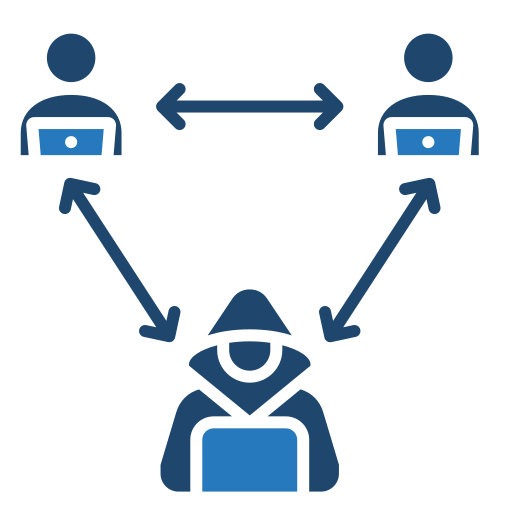Man-in-the-Middle (MITM)

A Man-in-the-Middle (MITM) attack occurs when an attacker secretly intercepts and possibly alters communication between two parties without them knowing. This allows the attacker to steal sensitive data, such as login credentials, financial information, or personal messages.
Recover from a MITM Attack#
Follow these steps to recover from such an attack:
Step 1: Identify the Attack#
- Look for signs of suspicious activity, such as unexpected SSL/TLS warnings or unrecognized devices on your network.
- Review logs for unusual or unauthorized activity, particularly in network traffic.
Step 2: Contain the Threat#
- Disconnect affected devices from the network immediately.
- Disable compromised accounts or sessions to prevent further unauthorized access.
- Change all potentially compromised passwords and credentials.
Step 3: Secure Communication Channels#
- Ensure all communications use encrypted protocols like HTTPS, SSH, or VPNs.
- Revoke and reissue SSL/TLS certificates if they have been compromised.
Step 4: Notify Relevant Parties#
- Inform your IT or security team about the attack.
- Notify any affected users or stakeholders about the potential exposure of sensitive information.
Step 5: Investigate and Remove the Attacker#
- Use network monitoring tools to locate and block the attacker’s access point.
- Identify and close any vulnerabilities that allowed the attack, such as open ports or weak passwords.
Step 6: Conduct a Security Audit#
- Perform a comprehensive audit of your systems to ensure no backdoors or further vulnerabilities remain.
- Review and update your security policies and infrastructure.
Step 7: Educate and Train Users#
- Provide training on recognizing MITM attack warning signs, such as fake login pages or certificate errors.
- Emphasize the importance of verifying secure connections and avoiding public Wi-Fi for sensitive transactions.
Mitigate the Risk of MITM Attacks#
Preventing MITM attacks requires secure communication practices, robust infrastructure, and user awareness. Follow these best practices:
Use Encrypted Connections#
- Enforce the use of HTTPS for all web traffic using SSL/TLS certificates.
- Require secure communication protocols like SSH, SFTP, and VPNs for remote access.
- Disable insecure protocols, such as HTTP and Telnet, on all devices.
Implement Strong Authentication#
- Use multi-factor authentication (MFA) to reduce the risk of compromised credentials.
- Require complex, unique passwords and rotate them regularly.
- Monitor and restrict access based on user roles and IP whitelisting.
Secure Your Network#
- Deploy firewalls and intrusion detection systems to monitor and block malicious traffic.
- Enable WPA3 encryption for wireless networks to protect against eavesdropping.
- Use VLANs to segment and isolate sensitive data from general traffic.
Monitor and Protect Endpoints#
- Install endpoint protection software to detect and block unauthorized activities.
- Keep all devices updated with the latest security patches and firmware.
- Use mobile device management (MDM) to enforce security policies on mobile devices.
Educate Users#
- Train users to identify phishing attempts, fake certificates, and other MITM attack vectors.
- Encourage users to verify URLs and certificates before entering sensitive information.
Conduct Regular Security Assessments#
- Perform regular vulnerability scans and penetration testing to identify weaknesses.
- Review your organization’s security policies and update them as necessary.
Develop a Response Plan#
- Create an incident response plan specifically for MITM attacks.
- Assign roles and responsibilities to ensure quick containment and recovery.
Use Advanced Security Tools#
- Deploy DNSSEC (Domain Name System Security Extensions) to protect DNS queries.
- Implement Certificate Pinning to prevent attackers from presenting fake certificates.
By following these strategies, you can significantly reduce the likelihood of MITM attacks and enhance the security of your organization’s communications.